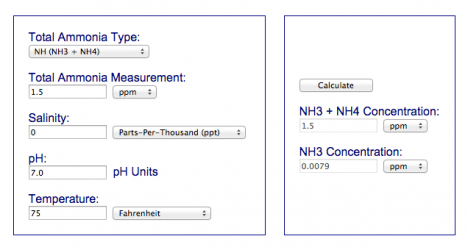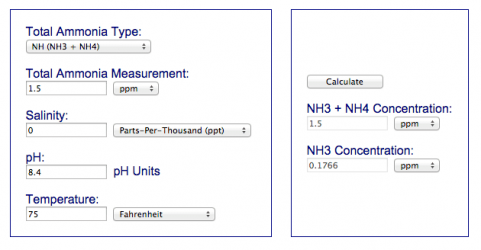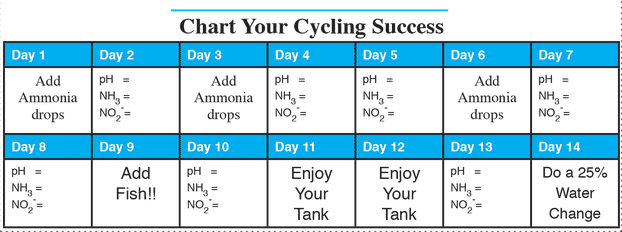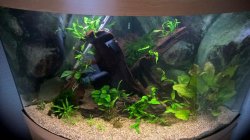You are using an out of date browser. It may not display this or other websites correctly.
You should upgrade or use an alternative browser.
You should upgrade or use an alternative browser.
Cycling Options
- Thread starter elmo666
- Start date
elmo666 said:Hi everyone. Has anyone any experience/used Tetra safe start instead of a fishless cycle? Thanks
I would suggest that if one were to go the Tetra Safestart (TSS) route, that it should be used in CONJUNCTION with the fishless cycle. Ultimately, TSS is extremely similar to Dr. Tims One and Only, and they do offer instructions on how to complete a fishless cycle with their product. I believe, that you can treat TSS exactly as Dr. Tim's product.
Using this product has no guarantee of success (which is why I suggest a fishless cycle) - as if the material is improperly handled it can be nullified.
We do have a history of members having success with this process, in the past.
TwoTankAmin
Fish Connoisseur
The concept behind bottled bacteria is similar to using things from established tanks to seed a new tank to get a jump start on cycling. The more bacteria one has to start, the faster you will have it reproduce to whatever the final needed quantity is. What differentiates various bacterial starter products is what they contain. As a rule, if you are unable to determine what strains of bacteria are being used, especially in terms of the nitrite oxidizing one's, you may not be getting the ones that will tend to persist over time.
If the product doesn't contain live bacteria, then it is not what you want to use. If it requires multiple additions, then they are not usually what you want to use. If they cannot get you fully cycled in about a week, they are not what you want to use.
Finally, if you want to use one of the viable products such as Dr Tim's or Safe Start, it is important that you follow their directions. That means you ignore a lot of what is in the cycling article here and, instead, do what the product directions tell you in this respect.
If the product doesn't contain live bacteria, then it is not what you want to use. If it requires multiple additions, then they are not usually what you want to use. If they cannot get you fully cycled in about a week, they are not what you want to use.
Finally, if you want to use one of the viable products such as Dr Tim's or Safe Start, it is important that you follow their directions. That means you ignore a lot of what is in the cycling article here and, instead, do what the product directions tell you in this respect.
Thanks for the reply guys.
Quick explanation of why I'm asking. First of all I don't understand how the live bacteria actually stays alive for an undetermined length of time in a bottle. I also don't know the science of how this product can go from zero to fully cycled* with full stocking, as suggested on their question and answers site when stocking African cichlids.
* They do actually say ammonia levels can be expected to be seen at 1-1.5ppm, in their words "stressful more so than toxic with no long term health issues"??
Now, why have I opted for the use of this over a fishless cycle you may ask. Well, part curiosity and a little bit of impatience, no, more keenness to see fish in a tank after I had no choice but to strip down my Discus tank due to a big operation stopping me from doing any sort of maintenance. Alas, again sadly, my 350ltr black aqua one set up had to go as the boss didn't think it went very well in her newly decorated and floored oak themed living room......a wood effect Juwel Trigon corner set up now sits nicely in their, albeit with a smaller capacity.
So, assuming the "cycle" goes ok, and 10 days in no detectable ammonia/nitrite in my Amazonian themed tank, at what put would a water change be a good idea? No indication on the instructions as to an appropriate timescale.
Quick explanation of why I'm asking. First of all I don't understand how the live bacteria actually stays alive for an undetermined length of time in a bottle. I also don't know the science of how this product can go from zero to fully cycled* with full stocking, as suggested on their question and answers site when stocking African cichlids.
* They do actually say ammonia levels can be expected to be seen at 1-1.5ppm, in their words "stressful more so than toxic with no long term health issues"??
Now, why have I opted for the use of this over a fishless cycle you may ask. Well, part curiosity and a little bit of impatience, no, more keenness to see fish in a tank after I had no choice but to strip down my Discus tank due to a big operation stopping me from doing any sort of maintenance. Alas, again sadly, my 350ltr black aqua one set up had to go as the boss didn't think it went very well in her newly decorated and floored oak themed living room......a wood effect Juwel Trigon corner set up now sits nicely in their, albeit with a smaller capacity.
So, assuming the "cycle" goes ok, and 10 days in no detectable ammonia/nitrite in my Amazonian themed tank, at what put would a water change be a good idea? No indication on the instructions as to an appropriate timescale.
Attachments
The way that I understand this particular product to work is this: the bacteria don't 'die', but instead go 'dormant'. Remember bacteria are far different from animals and can cope with far different conditions. However, if improperly handled, or bottled for too long, then they can die and will be a worthless addition to your tank. Also, if the ammonia levels are too high when using this product, that can also carry dire consequences for the bacteria (and your cycle).
The reason they make such a claim is this: they are assuming that you are using a test kit like API or similar, which measures the total ammonia (both the toxic NH3, and the much less dangerous NH4). Using this website: http /www.hamzasreef.com/Contents/Calculators/FreeAmmonia.php you can determine how much of the ammonia is actually the 'dangerous' variety. You MUST keep the levels under 0.05 ppm of the dangerous variety, if I remember correctly, though it is different for different species.
/www.hamzasreef.com/Contents/Calculators/FreeAmmonia.php you can determine how much of the ammonia is actually the 'dangerous' variety. You MUST keep the levels under 0.05 ppm of the dangerous variety, if I remember correctly, though it is different for different species.

Notice that at a 'neutral' pH, and 75 Fahrenheit, that the 'free ammonia' (NH3 - the bad stuff) is at a level of 0.0079 ppm, which is actually not at a true 'danger' level.
HOWEVER, look at what happens when you have a pH in the range of what would be needed for the African cichlids:

This level of free ammonia is TOXIC and will kill your fish, and do so in a fairly short amount of time. Even at a pH of 'only' 8.0, the free ammonia levels are 0.0757 ppm, or 50% higher than the 'toxic' level, which still means the fish aren't likely to survive, and at the very least WILL suffer long term health issues and will also likely suffer short term ailments as their immune systems will be extremely compromised and secondary problems will arise.
So, while I understand your curiosity and keenness to see fish in the tank as quickly as possible... I would suggest that the worst possible scenario, would be using this product for a fish-in cycle with African cichlids.
Instead, I would suggest that you use the product as directed on Dr. Tim's website for a fishless cycle. You could be ready for fish in as little as 9 days... http /store.drtimsaquatics.com/Recipes_ep_54-1.html
/store.drtimsaquatics.com/Recipes_ep_54-1.html

The ammonia drops being described here really just mean to add ammonia to raise the ammonia level to 1 ppm. You can use the calculator found here at TFF to figure out how much ammonia you would have to use.
***Disclaimer - I've never used this method, but I believe that it is a far better option than jumping in with the fish in cycle. If it doesn't work as promised, all you'll lose is time. If you do the fish-in cycle and it doesn't work as described by the manufacturers, then you will lose time AND your fish.
* They do actually say ammonia levels can be expected to be seen at 1-1.5ppm, in their words "stressful more so than toxic with no long term health issues"??
The reason they make such a claim is this: they are assuming that you are using a test kit like API or similar, which measures the total ammonia (both the toxic NH3, and the much less dangerous NH4). Using this website: http
 /www.hamzasreef.com/Contents/Calculators/FreeAmmonia.php you can determine how much of the ammonia is actually the 'dangerous' variety. You MUST keep the levels under 0.05 ppm of the dangerous variety, if I remember correctly, though it is different for different species.
/www.hamzasreef.com/Contents/Calculators/FreeAmmonia.php you can determine how much of the ammonia is actually the 'dangerous' variety. You MUST keep the levels under 0.05 ppm of the dangerous variety, if I remember correctly, though it is different for different species. 
Notice that at a 'neutral' pH, and 75 Fahrenheit, that the 'free ammonia' (NH3 - the bad stuff) is at a level of 0.0079 ppm, which is actually not at a true 'danger' level.
HOWEVER, look at what happens when you have a pH in the range of what would be needed for the African cichlids:

This level of free ammonia is TOXIC and will kill your fish, and do so in a fairly short amount of time. Even at a pH of 'only' 8.0, the free ammonia levels are 0.0757 ppm, or 50% higher than the 'toxic' level, which still means the fish aren't likely to survive, and at the very least WILL suffer long term health issues and will also likely suffer short term ailments as their immune systems will be extremely compromised and secondary problems will arise.
So, while I understand your curiosity and keenness to see fish in the tank as quickly as possible... I would suggest that the worst possible scenario, would be using this product for a fish-in cycle with African cichlids.
Instead, I would suggest that you use the product as directed on Dr. Tim's website for a fishless cycle. You could be ready for fish in as little as 9 days... http
 /store.drtimsaquatics.com/Recipes_ep_54-1.html
/store.drtimsaquatics.com/Recipes_ep_54-1.html
The ammonia drops being described here really just mean to add ammonia to raise the ammonia level to 1 ppm. You can use the calculator found here at TFF to figure out how much ammonia you would have to use.
***Disclaimer - I've never used this method, but I believe that it is a far better option than jumping in with the fish in cycle. If it doesn't work as promised, all you'll lose is time. If you do the fish-in cycle and it doesn't work as described by the manufacturers, then you will lose time AND your fish.
TwoTankAmin
Fish Connoisseur
Just to add to what eagle wrote. When the bacteria go dormant, there are several factors that will effect things. Reasearch shows that the recovery phase for the bacteria depends upon two things. First, the condition they are in when they go dormant. In the viable bottled products they are in the best best shape possible. Next, how long it takes them to recover depends on how long they have been dormant. And here eagle was a bit off the mark.
With a product such as Dr. Tim's you are looking at three basic time frames. The first is in regards to how long the bacteria will be of help within a short period of time after being given "food." If the bottle is not refrigerated, then this is about 6 months. However, the second is if the bottle is refrigerated and then this recovery will happen even after about one year. After the end of either period the bacteria are not all dead by any means. However, they have been dormant for so long that recovery is also so long as not to give almost any benefit for cycling a tank.You might shave a day or two this way. As Dr. Hovanec explained to me in one of our email exchanges, using bacteria that old is better than using nothing at all, but that is about it. Nitrifying bacteria can stay dormant and still be viable for a long time, but that doesn't mean they can still accelerate a cycle.
As for ammonia issues. The reason Dr. H. is not overly concerned about a brief period with 1 -1.5 ppm of ammonia is that it will not last very long. But bear in mind that if one doesn't want to do a brief fishless cycle, then one should also not fully stock the tank all at once.
 /www.drtimsaquatics.com/resources/helpful-hints/one-and-only-nitrifying-bacteria-faqs
/www.drtimsaquatics.com/resources/helpful-hints/one-and-only-nitrifying-bacteria-faqs
With a product such as Dr. Tim's you are looking at three basic time frames. The first is in regards to how long the bacteria will be of help within a short period of time after being given "food." If the bottle is not refrigerated, then this is about 6 months. However, the second is if the bottle is refrigerated and then this recovery will happen even after about one year. After the end of either period the bacteria are not all dead by any means. However, they have been dormant for so long that recovery is also so long as not to give almost any benefit for cycling a tank.You might shave a day or two this way. As Dr. Hovanec explained to me in one of our email exchanges, using bacteria that old is better than using nothing at all, but that is about it. Nitrifying bacteria can stay dormant and still be viable for a long time, but that doesn't mean they can still accelerate a cycle.
As for ammonia issues. The reason Dr. H. is not overly concerned about a brief period with 1 -1.5 ppm of ammonia is that it will not last very long. But bear in mind that if one doesn't want to do a brief fishless cycle, then one should also not fully stock the tank all at once.
from http
How many fish can I add to the aquarium after dosing with One & Only?
This is the hardest question to answer because every situation is different. One & Only will dramatically reduce the time it takes to establish a biofilter in your newly set-up aquarium. However, even One & Only has limits.
For instance, if you set up a saltwater tank and use uncured live rock, One & Only may not be able to initially control the ammonia concentration in the water because there will be too much decay of organic matter from the uncured live rock.
Or if you let every friend of your kids feed the new fish tank such that you are grossly overfeeding the tank, One & Only will not be able to maintain low levels of ammonia and nitrite.
Also, some fish species are very sensitive to any amount of ammonia in the water so these fish should be added to the tank in the first 20 or so days after set-up.
In general, you can add one giant danio-sized fish per gallon when initially dosing with One & Only. Feed normally and monitor ammonia and nitrite levels in the water. You might see a little ammonia or nitrite for a day or so but this will quickly disappear. You can then add more fish to the aquarium.
 /www.drtimsaquatics.com/resources/helpful-hints/one-and-only-nitrifying-bacteria-faqs
/www.drtimsaquatics.com/resources/helpful-hints/one-and-only-nitrifying-bacteria-faqsAgain, great replies, much appreciated. I've always understood the impact of NH3/4 and it's toxicity relative to ph. Now, the reason I opted for this approach using Safe Start was the assurances I received regarding itself safe and effective performance. I'm not one to "fiddle" too much with my tank once its set up, in so much as I know what I want to stock from the outset and source good specimens of those accordingly. With my choice for this tank all being relatively sensitive, therein lay my dilemma, what to initially stock? So, knowing I wanted a large shoal of cardinals, white tipped tetra, coryadoras sterbai and an L plec of some sort, I felt the only real option for the start up quantity suggested were the cardinals, adding 40 to start. Their looking extremely well, with their colours and confidence noticeably improving daily. I will admit to having my concerns knowing their reputation for being sensitive.
But, as said, so far so good. Just have to decide now when to implement my weekly water changes, 100% r/o re-mineralised. I'm assuming dosing regularly with ferts won't impact on the cycling process. Thanks again for your input.
But, as said, so far so good. Just have to decide now when to implement my weekly water changes, 100% r/o re-mineralised. I'm assuming dosing regularly with ferts won't impact on the cycling process. Thanks again for your input.
I suppose I misunderstood your stocking plans... the pH for cardinal tetras, etc. is not going to be as dangerous as for the African cichlids, so that is going to help you.
One thing to watch though is the stocking amount. Generally, TSS suggests starting with a 'few fish'... and the amount of TSS you add is dependent on your tank's volume. You can't add 'too many' in terms of the bacteria, but you can add 'too few'. So, you might end up seeing higher levels than you would had you gone with a smaller starting group of fish.
Though if your tank is planted as your picture that will help a bit, though it seems like you have a fair amount of slower growers, though your signature indicates that you are using CO2, etc. so that will increase the nitrogen usage by the plants and the plants will be using ammonium from the water which will lessen the amount needed to be dealt with by the bacteria.
One thing to watch though is the stocking amount. Generally, TSS suggests starting with a 'few fish'... and the amount of TSS you add is dependent on your tank's volume. You can't add 'too many' in terms of the bacteria, but you can add 'too few'. So, you might end up seeing higher levels than you would had you gone with a smaller starting group of fish.
Though if your tank is planted as your picture that will help a bit, though it seems like you have a fair amount of slower growers, though your signature indicates that you are using CO2, etc. so that will increase the nitrogen usage by the plants and the plants will be using ammonium from the water which will lessen the amount needed to be dealt with by the bacteria.
Thanks eagles. Yes, I am using co2 in conjunction with seachem flourish and iron. Just edited my signature as that was for my previous tank. I do like the slower growing plants, though that said I'm toying with the idea of some stem plants across the rear, cabomba or red bacopa, or maybe some giant vallis.
Similar threads
- Replies
- 16
- Views
- 583
- Replies
- 103
- Views
- 3K

